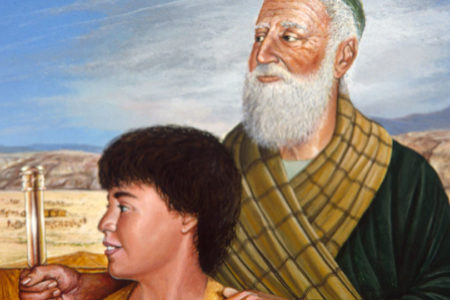No Middle Wall
With His talk of crucifixion at Jerusalem, Jesus’ disciples were struck dumb with consternation. Their anticipation and preparation had been geared for the coming Kingdom—a literal, one-thousand-year era during which the Messiah/King Himself would take His throne and reign from Jerusalem. With them as His regents, He would establish justice, peace, and righteousness as the standard for the new order.
But it was not to be. The King would be rejected and the Kingdom set aside for an indefinite period. His Kingdom would indeed come one day, but in the interim God would produce another wonder—the Church. To the disciples and their prophet predecessors, it was totally unexpected, “the mystery of Christ which in other ages was not made known unto the sons of men” (Eph. 3:4b–5a). The Church would be a new order of another sort, accomplishing, through the cross work of the Messiah, what had eluded human, imperial master builders across the centuries. Remnants from every nation on earth would be brought into a heretofore unknown relationship of love and loyalty to their Savior/Sovereign, Jesus Christ. To this point, God’s program had been administered through the Jewish nation. Now it would become all-inclusive; no middle wall was to stand between Jew and Gentile. The gospel of Christ would offer divine reconciliation to all men everywhere.
For he is our peace, who hath made both one, and hath broken down the middle wall of partition between us, Having abolished in his flesh the enmity, even the law of commandments contained in ordinances, to make in himself of two one new man, so making peace (Eph. 2:14–15).
The Law, the greatest of all schoolmasters, had done its work. It guided Jewry “unto Christ, that we might be justified by faith” (Gal. 3:24). The revered but inadequate Law was giving way to something far more wonderful and encompassing—a body bound by faith in Christ alone, where “There is neither Jew nor Greek, there is neither bond nor free, there is neither male nor female; for ye are all one in Christ Jesus” (Gal. 3:28). Lest there be confusion about who stood where in the Church, God spelled it out very carefully.
“That the Gentiles should be fellow heirs, and of the same body, and partakers of his promise in Christ by the gospel” (Eph. 3:6). “And if ye be Christ’s, then are ye Abraham’s seed, and heirs according to the promise” (Gal. 3:29).
The very character of the Church was to be a witness to oneness in Christ: “one new man,” “one body,” one as “citizens,” one “household,” one “building,” one “holy temple in the Lord,” one “habitation of God through the Spirit” (Eph. 2:14–22).
Believing Jews and Gentiles in UNITY—a new phenomenon on the face of the earth. Testimonially, it is irresistible and irrefutable evidence of the power of the gospel to fully accomplish what man never could. It is a condition exemplified by the fact that the Passover table gave way to the communion table, where Jewish and Gentile brothers and sisters sit as members of the same family because “Christ, our passover, is sacrificed for us” (1 Cor. 5:7).
The “Let’s Go Back” Syndrome
This new condition, fundamental as it is to what God is demonstrating in the Church, has encountered resistance. Indeed, the concept is so radical to the human mind that, for nearly 2,000 years, some on both sides of the line have attempted to redefine and improve on God’s new creation. It is a situation that must be constantly monitored as various elements fall prey to the temptation of yearning to return to the old ways.
Going Back Culturally
Israel escaped Egyptian bondage under the sheltering blood of the Passover lamb. With faces set toward the promised land, they were returning to the place given to them through Abraham. God was surely doing a new thing in their midst. But it was not long before some were weeping for “the fish which we did eat in Egypt freely; the cucumbers, and the melons, and the leeks, and the onions, and the garlic” (Num. 11:5). Manna, so abundantly and graciously provided by the Lord, had become tasteless; the way was difficult; the pilgrim’s life, too, they found, had its problems. Ultimately, the cry that was rising in some of their minds was articulated: “Let us return to Egypt.”
What had happened? Why did they long to return to a place where they had known such suffering and servitude? The fact is, these would-be returnees were uncomfortable with their new situation—the new culture. They were having difficulty breaking away. Their hearts were still in Egypt!
This was, of course, nothing new. God has placed within us a certain reverence for things familiar. I can remember as a youngster the dual lives led by some of my peers whose grandparents were immigrants from Europe. Their elders clung to the ways of the “old country.” They were having great difficulty adapting to their new culture. Some never would adapt and drew a circle about themselves, which isolated them from the community and the reality of their new condition.
More objective people realized that they now had a new life. And while there were elements of their European heritage that could be retained and enjoyed, they now lived with a superior reality: life in the “new country.”
This quiet conflict goes on constantly as new believers enter the fold, and more mature Christians wrestle with questions of how to effectively relate to the culture in which they currently find themselves. In this regard, temptation wears two faces: assimilation and domination.
Assimilation is the problem of being captured by the culture and becoming so like the Egypt surrounding us that we lose our identity and, hence, our effectiveness for Christ. It is the far side of lifestyle evangelism. To penetrate the culture, in order to reach the lost, is a legitimate pursuit. When, however, we become absorbed by the culture and more like the world than Christ, we have lost our way and completely missed the point of what being “in the world, but not of it” is all about. Such assimilation is paralyzing much of the contemporary Church.
Cultural domination is a condition that exists when believers develop such a fixation with their ethnic culture that it dominates their lifestyle and divides them from other Christians. A Jewish friend and I were discussing this problem. He, being an Israeli, was very sensitive to the tensions of retaining ethnic identity while demonstrating a positive lifestyle for the Messiah. “The only culture that counts for a believer,” he said with great emphasis, “is the Christ culture!” His emphasis was correctly placed. Christ, in all aspects of His person and purposes, is the dominant reality in the lives of those who are members of the Church family.
Divine creativity is never more clearly demonstrated than in the life of the local church. Here Jew and Gentile are joined together as a family in the Lord. Incidental cultural mores acquiesce to the “Christ culture.” In a demonstrable way, “with brotherly love, in honor preferring one another [all believers]” (Rom. 12:10) becomes a witnessing force that confronts the community with the reality of Christ. No cultural middle wall divides His people!
Going Back to the Law
The Epistle to the Galatians was written to address two fundamental problems. First, some were teaching that, while salvation was of Christ, works were also necessary for salvation. They were turning again “to the weak and beggarly elements,” which were bringing them “again to be in bondage.” They were “[observing] days, and months, and times, and years” (Gal. 4:9–10). In other words, these believers were succumbing to the fallacy that keeping the Law was an integral part of the gospel message. Faith in Christ was not sufficient; they must return to the Law as well. Not only was this a perversion of the faith, but Paul labeled it “another gospel” (Gal. 1:6). He then added forcefully, “But that no man is justified by the law in the sight of God, it is evident; for, The just shall live by faith” (Gal. 3:11).
A second error addressed in Galatians was the teaching that a believer is somehow made more spiritual by keeping the Law. It is the better way for mature Christians to live. Indeed, many Jewish believers today are encouraged to keep the Law because, they are told, it is the way true Jews should prefer to live. Companion theories are pressed upon Gentile Christians as well. Both concepts are grossly in error.
The Law is unkeepable! The central purpose of the Law was not to perfect maturity in the saints; it was to prove, once and for all, that we need a Savior (Gal. 3:23–25). Therefore, Jesus Christ did not come to be an appendix to the Law of Moses. Rather, “Christ hath redeemed us from the curse of the law, being made a curse for us; for it is written, Cursed is everyone that hangeth on a tree” (Gal. 3:13). Through trusting the cross work of Jesus Christ, servants in bondage to the Law become sons in the faith. “Wherefore [because we are redeemed], thou art no more a servant, but a son; and if a son, then an heir of God through Christ” (Gal. 4:7).
That people who were proven dead in sin, through their inability to keep the condemnatory Law of Moses, are made alive to another law—“the law of Christ” (Gal. 6:2)—is the great transforming wonder produced by the gospel in believers. The epitome of returning to “the weak and beggarly elements” is the call to be perfected in your faith by attempting to keep the Law of Moses. In this we are well instructed by the apostle: “Stand fast, therefore, in the liberty with which Christ hath made us free, and be not entangled again with the yoke of bondage” (Gal. 5:1).
Going Back into Judaism
During the early days of the Church era, Jewish believers were faced with transitional questions that worked themselves out in due course as the composition and nature of the Church were clarified (see Will Varner’s article). Extremities of the problem are identified in the Book of Hebrews where the writer deals with the issue of Jewish believers incorporating Judaism into their worship and lifestyle. The Temple was standing at the time Hebrews was written, and the forms and rituals of their former way of life had a strong magnetism for those who were not wholly committed to full salvation in Christ. Some were wavering between Christ and returning to the rituals and requirements of Judaism. The key word in Hebrews is better. The good things of biblical Judaism had been made better in Jesus Christ.
He is better than angels (Heb. 1:4).
He is better than Moses (Heb. 3:3).
He is better than Aaron (Heb. 7:11–22).
His New Covenant is better than the Old (Heb. 8:6–13).
Judaism, in the divine plan, had become only a “shadow of things to come” (Col. 2:17). Its temporary role gave way to Christ, who transformed the shadow into substance and reared a “greater and more perfect tabernacle, not made with hands” (Heb. 9:11). “For Christ is not entered into the holy places made with hands, which are the figures of the true, but into heaven itself, now to appear in the presence of God for us” (Heb. 9:24).
In totality, Hebrews emphatically sets forth the departure of the Old Covenant, with its institutions and rituals, in favor of Christ and the New Covenant. As the Law was a schoolmaster to bring us to Christ, Judaism, with its sanctuary, sacrifices, services, and ceremonies, served to identify Him. Once this was done, biblical Judaism had served its lofty purpose. It was consummated in Christ.
Thus, the destruction of the Temple in 70 A.D., while legitimately mourned as a lost architectural treasure, could not be wept for as an imparter of spiritual light and life. A greater light had arrived, entered the heavenly sanctuary with His own blood once for all (Heb. 9:12), and made all earthly altars obsolete.
But, as man is prone to do, even with the Temple gone from the scene, Jewry clung to the system. The rabbinic leadership maintained a Pharisaic form of Judaism. And, as had been true with the Sadduceean Temple leadership, they were resolutely opposed to the deity of Jesus and the legitimacy of His messianic credentials. Therefore, reconciliation between believers in the Messiah and rabbinic Judaism was an impossibility. The breach endures to this day, and Hebrew Christians who attempt to reenter Judaism, or at least be tolerated as a branch of the rabbinic system, are simply not acceptable to contemporary Judaism.
The issue is not Hebrew Christians retaining their identity as Jews—those made Jewish by God will remain so, whether they are in a synagogue or a church. No, the issue is Jesus, the Messiah, and regardless of which form of His name one chooses to use, He is not acceptable to or compatible with the synagogue and rabbinic Judaism.
Thus, the admonition to the Hebrews was not to go back but to go on to those better things in the Messiah. “Let us go forth, therefore, unto him outside the camp, bearing his reproach” (Heb. 13:13).
Gentile believers who have left religious systems that deny the deity of Christ and substitute ritual for spiritual reality often face a dilemma as acute as that of their Jewish brethren. While family, forms, familiar objects, heritage, surroundings, cathedrals, and the like beckon a return, it is impossible as long as Christ and His Word do not have preeminence. The decision must be made: to go back or to go on in the better things possessed in Christ.
A Word for the Church
As we have seen, the Church is not an option among various alternatives for believers—Jew or Gentile. The Church is God’s unique new creation for edifying His people during this age of grace and for evangelizing a lost world. The central pillar of this new reality is, as stated above, Jew and Gentile, interspersed in the same fellowships the world over, testifying faithfully to the power of the gospel and the transcending love of Christ. God clearly intends to use this clarifying object lesson to provoke in people a desire for that which believers have found in Christ. But, beyond the magnetism generated by Christ-honoring assemblies of saints, He has created the Church for an even higher purpose: to show forth His wisdom and His glory. In so doing, He magnifies the glories of all that has been—the Law, the prophets, the sanctuary—and displays before men and created beings in other realms the surpassing wonder of what His plan has progressively created.
To the intent that now, unto the principalities and powers in heavenly places, might be known by the church the manifold wisdom of God … Unto him be glory in the church by Christ Jesus throughout all ages, world without end. Amen (Eph. 3:10, 21).
The profound implication of God’s choosing to demonstrate His glory and wisdom through the Church is a humbling revelation. It is also a call to appreciate the imperative of relationships within the Church and to renew our commitment to unity and sensitivity. No one should feel out of place in an assembly of believers. After all, the Church is the Christian’s normal environment. All members of the family should be warmly received and cared for. Jewish brethren bring in historical and cultural associations that can inestimably enrich the lives of fellow believers. Gentile family members contribute in like manner. That is precisely how God chose to arrange things. It is the norm for His Church!








